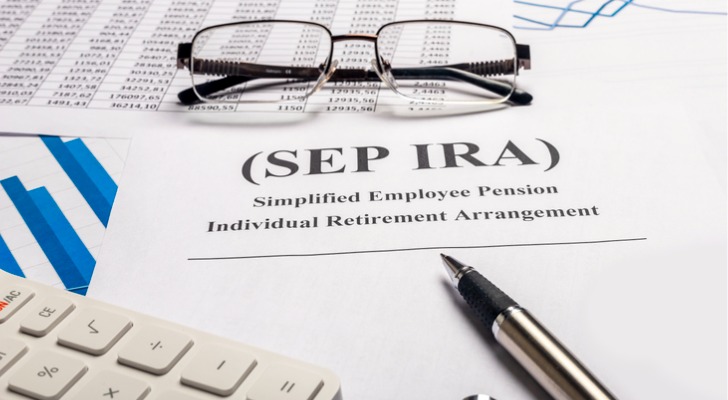Retirement plans, like simplified employee pension (SEP) IRAs, go hand-in-hand with attractive tax benefits. Designed for self-employed individuals and small business owners, SEP IRAs allow employers to directly contribute to their employees’ retirement accounts and their own. In return, they will receive a tax deduction. However, there are other tax benefits associated with this type of retirement plan.
A financial advisor can help you save and plan for retirement. Connect with a fiduciary advisor today.
What Is a SEP IRA?
While traditional IRAs and Roth IRAs are established outside of the workplace, SEP IRAs are defined contribution plans that businesses of any size can set up for their employees. However, SEP IRAs are particularly attractive for small business owners and self-employed workers because of their simplicity and generous contribution limits.
Unlike a 401(k) plan, SEP IRAs are funded entirely by the employer – not the employee. These contributions, which should be an identical percentage of the salary for each worker, are immediately vested.
SEP IRAs also come with higher annual contribution limits compared to traditional IRAs and their Roth counterparts. Because of these higher contribution limits, small business owners, self-employed individuals, freelancers and independent contractors can enjoy more substantial retirement savings. Plus, the simplicity and flexibility of a SEP IRA make it favored among small businesses with fluctuating profits.
Who Can Open a SEP IRA?
The eligibility criteria for opening a SEP IRA is simple. The IRS stipulates that if you’re self-employed, a small business owner with at least one employee, a sole proprietor, part of a partnership, a corporation, or an S corporation, you can open a SEP IRA. These criteria help ensure that the benefits of a SEP IRA are accessible to diverse business structures.
Who Can Participate in a SEP IRA?
The participation rules in a SEP IRA closely mirror its intuitive nature. Employees who are at least 21 years old, have been employed with the same employer for three out of the last five years and have received a minimum of $750 in compensation in the current year are considered eligible according to IRS guidelines. Keep in mind that as an employer, you can use less stringent eligibility requirements, but not more intensive ones.
SEP IRA Contribution Limits
As mentioned above, SEP IRAs come with significantly higher contribution limits when compared with traditional or Roth IRAs. As of 2024, the maximum contribution is the lesser of 25% of the employee’s compensation or $69,000 (up from $66,000 in 2023). These figures, however, may be subject to change, making it important to stay updated on the recent regulations.
Tax Benefits for the Employer

Beyond benefiting the employees, SEP IRAs also offer substantial tax benefits to employers. Per the IRS guidelines, employers can deduct the lesser of the contributions made or 25% of the employee’s compensation. Compared with 401(k) plans, SEP IRAs allow for more substantial deductions. However, unlike 401(k) plans, SEP IRAs do not permit employee matching, which could be a trade-off for some businesses.
SEP IRAs offer opportunities for strategic tax planning, particularly for business owners looking to maximize tax efficiency. By contributing to a SEP IRA, a business owner can effectively lower their taxable income and potentially move into a lower tax bracket. Additionally, they can time their contributions strategically to optimize tax savings based on the business’s financial performance.
Tax Benefits for the Employee
While employees don’t receive an annual tax deduction for contributing to the plan, they do benefit from the tax-deferred growth of their SEP IRA. This means they don’t pay taxes on the earnings until they take distributions in retirement, which can potentially lead to more robust investment growth. Because the money isn’t taxed until it’s withdrawn, SEP IRA holdings aren’t subject to the same tax drag as investments held in a taxable brokerage account.
How to Set Up a SEP IRA
Setting up a SEP IRA is a straightforward process involving choosing a willing financial institution, putting the plan in place (often using IRS Form 5305-SEP), notifying employees and initiating contributions.
- Choose a provider: First, you’ll need to select a financial institution or investment firm to set up your SEP IRA. It’s essential to research different providers and compare their fees, investment options and customer service offerings. Look for a provider that aligns with your business’s needs and values.
- Establish your plan: Once you’ve chosen a provider, the process of setting up your SEP IRA is relatively straightforward. You’ll need to complete a SEP IRA adoption agreement, which outlines the terms and conditions of the plan, including eligibility requirements and contribution amounts. This document will need to be retained for your records.
- Communicate with employees: Transparency and communication are key when implementing a SEP IRA for your business. Be sure to inform your employees about the new retirement plan, including eligibility criteria, contribution amounts and any other relevant details. Providing educational resources or holding informational sessions can help employees understand the benefits of participating.
- Start contributions: As the employer, you have the responsibility of making contributions to your employees’ SEP IRAs. Contributions are discretionary, meaning you can choose how much to contribute each year based on your business’s financial situation. Keep in mind that contributions must be made consistently and cannot discriminate in favor of highly compensated employees.
- Stay compliant: It’s crucial to stay informed about the rules and regulations governing SEP IRAs to ensure compliance with the IRS. This includes adhering to contribution limits, filing required paperwork and reporting contributions accurately on tax forms.
Pros and Cons of a SEP IRA

The tax benefits of offering a SEP IRA to employees are among the most consequential advantages of this type of retirement plan. However, there are drawbacks you should keep in mind as an employer.
Pros of a SEP IRA
- Simplicity and flexibility: SEP IRAs offer straightforward setup and administration processes, making them ideal for small businesses with few or no employees.
- Tax advantages: Contributions made to SEP IRAs are tax-deductible for employers, reducing taxable income and potentially lowering their tax liability. Additionally, earnings within the account grow tax-deferred until withdrawal, allowing for potential compounded growth over time.
- High contribution limits: SEP IRAs have higher contribution limits compared to traditional IRAs, allowing individuals to save more for retirement. This can be particularly advantageous for self-employed individuals seeking to maximize their retirement savings.
- Contributions aren’t mandatory: Unlike some retirement plans, such as 401(k)s, SEP IRAs do not require employers to make contributions annually. This flexibility allows employers to adjust contributions based on their financial circumstances each year.
Cons of a SEP IRA
- Employer contributions only: SEP IRAs are funded solely by employer contributions, which means employees cannot contribute to their accounts through salary deferrals. This limitation may not be ideal for businesses with employees who wish to contribute to their retirement savings.
- Equal contribution requirement: Employers must make proportional contributions to all eligible employees, including themselves, based on a set percentage of compensation. This can be disadvantageous if the employer has a large workforce or wants to prioritize contributions for specific employees.
- No catch-up contributions: Unlike some retirement plans, such as 401(k)s and traditional IRAs, SEP IRAs do not offer catch-up contributions for individuals aged 50 and older. This may limit the ability of older individuals to accelerate their retirement savings in later years.
SEP IRA vs. Solo 401(k)
Also known as a one-participant or individual 401(k), solo 401(k)s are designed for self-employed individuals with no employees other than a spouse. Unlike SEP IRAs, these plans allow for both employer and employee contributions.
For 2024, the total contribution limit for solo 401(k)s is $69,000, which comprises both the employee and employer portions. Unlike SEP IRAs, people 50 and older can make catch-up contributions to a solo 401(k). As a result, someone who’s 50 or older can save up to $76,5000 in a solo 401(k) in 2024.
Bottom Line
SEP IRAs are unique workplace retirement plans that enable employers to make tax-deductible contributions to their employees’ accounts. While SEP IRAs have higher contribution limits than 401(k)s plans and other IRAs, they also confer different tax benefits. Unlike 401(k)s and similar accounts, the employee doesn’t get a tax deduction for the contribution – the employer does. Employers also have the flexibility to increase or decrease their contributions from year to year, giving them more tax planning flexibility.
Tips for Retirement Savers
- Saving is the first and more crucial step of retirement planning. However, it’s also important to track your progress and get a sense of whether your savings will be enough when the time comes to retire. SmartAsset’s retirement calculator can help you estimate how much money you’ll have down the road and whether it may be enough to support your desired level of spending.
- A financial advisor can help you manage your retirement savings and plan for your golden years. Finding a financial advisor doesn’t have to be hard. SmartAsset’s free tool matches you with up to three vetted financial advisors who serve your area, and you can have a free introductory call with your advisor matches to decide which one you feel is right for you. If you’re ready to find an advisor who can help you achieve your financial goals, get started now.
Photo credit: ©iStock.com/valiantsin suprunovich, ©iStock.com/Prostock-Studio, ©iStock.com/gorodenkoff
